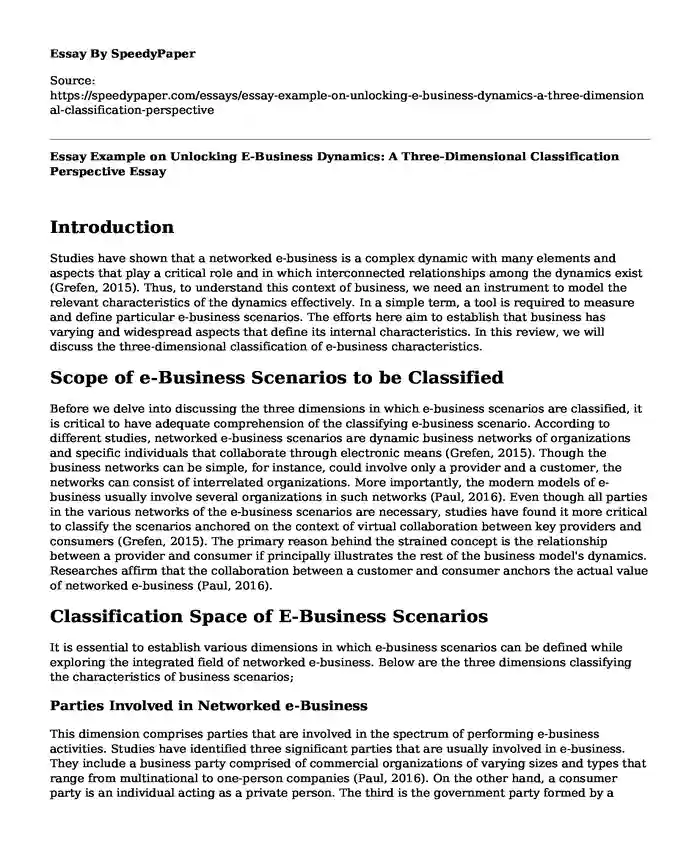
| Type of paper: | Essay |
| Categories: | Business Social networks |
| Pages: | 3 |
| Wordcount: | 660 words |
Introduction
Studies have shown that a networked e-business is a complex dynamic with many elements and aspects that play a critical role and in which interconnected relationships among the dynamics exist (Grefen, 2015). Thus, to understand this context of business, we need an instrument to model the relevant characteristics of the dynamics effectively. In a simple term, a tool is required to measure and define particular e-business scenarios. The efforts here aim to establish that business has varying and widespread aspects that define its internal characteristics. In this review, we will discuss the three-dimensional classification of e-business characteristics.
Scope of e-Business Scenarios to be Classified
Before we delve into discussing the three dimensions in which e-business scenarios are classified, it is critical to have adequate comprehension of the classifying e-business scenario. According to different studies, networked e-business scenarios are dynamic business networks of organizations and specific individuals that collaborate through electronic means (Grefen, 2015). Though the business networks can be simple, for instance, could involve only a provider and a customer, the networks can consist of interrelated organizations. More importantly, the modern models of e-business usually involve several organizations in such networks (Paul, 2016). Even though all parties in the various networks of the e-business scenarios are necessary, studies have found it more critical to classify the scenarios anchored on the context of virtual collaboration between key providers and consumers (Grefen, 2015). The primary reason behind the strained concept is the relationship between a provider and consumer if principally illustrates the rest of the business model's dynamics. Researches affirm that the collaboration between a customer and consumer anchors the actual value of networked e-business (Paul, 2016).
Classification Space of E-Business Scenarios
It is essential to establish various dimensions in which e-business scenarios can be defined while exploring the integrated field of networked e-business. Below are the three dimensions classifying the characteristics of business scenarios;
Parties Involved in Networked e-Business
This dimension comprises parties that are involved in the spectrum of performing e-business activities. Studies have identified three significant parties that are usually involved in e-business. They include a business party comprised of commercial organizations of varying sizes and types that range from multinational to one-person companies (Paul, 2016). On the other hand, a consumer party is an individual acting as a private person. The third is the government party formed by a government organization and interlinked non-profit organizations such as public education organizations. The three parties in this context can collaborate at different levels. The relationship here can have the model, consumer-to-consumer, business-to-business, and government-to-government. All parties can be interrelated with each other at all levels i.e., consumer-to-business or business-to-government.
Objects Involved in Networked e-Business.
Objects of networked e-business comprise the values that are traded by e-business activities or scenarios. The objects in e-business are fundamental to a complete model. They include physical goods, digital goods, services, financial goods, and hybrid goods. Usually, the differences between these objects are not very clear. In a general view, trading objects involve financial objects or the actual product or service.
Time Scope of Networked e-Business
In this dimension, some options classify e-business scenarios concerning the time frame scope of given e-business activities. This dimension has the following values in time scope; static time scope, semi-dynamic time scope, dynamic time scope, and ultra-dynamic scope (Paul, 2016). It is very important to note that scenarios with more dynamic time scopes are more fascinating ones.
Conclusion
E-business scenarios must be adequately evaluated with a distinct modeled separation of concern by establishing aspects of such scenarios. The three dimensions of e-business define parties, objects, and the scope of time taken in collaboration. A critical evaluation of each dimension's various values is again very crucial in understanding the context of e-business. This approach helps one demonstrate the knowledge of the fundamentals of e-business and adequately understand the practical application of e-business.
References
Grefen, P. (2015). Beyond e-business: Towards networked structures. ProQuest eBook Central https://ebookcentral.proquest.com
Paul Grefen. (2016). Beyond E-Business: Towards Networked Structures. Routledge.
Cite this page
Essay Example on Unlocking E-Business Dynamics: A Three-Dimensional Classification Perspective. (2024, Jan 08). Retrieved from https://speedypaper.com/essays/essay-example-on-unlocking-e-business-dynamics-a-three-dimensional-classification-perspective
Request Removal
If you are the original author of this essay and no longer wish to have it published on the SpeedyPaper website, please click below to request its removal:
- Cyber Crimes Essay Sample
- Free Essay in Organizational Theory and Design: Air Canada
- Free Essay about Digital Transformation in the Travel Industry
- Essay Example Dedicated to Federal Register and Foundation Center
- Free Essay. Damages in a Car Accident
- Essay Example. Annotated Bibliography on the Effects of the Internet on Today's Youth
- Essay Example: Business Site Selection
Popular categories




